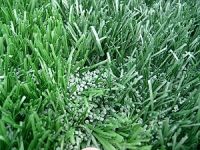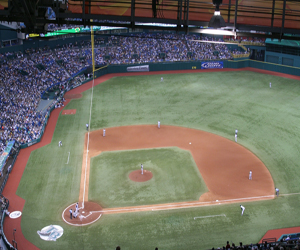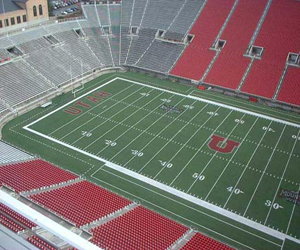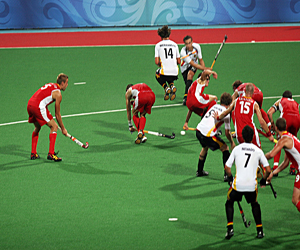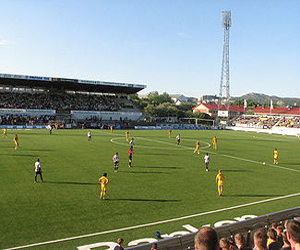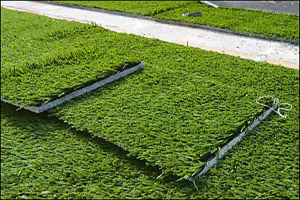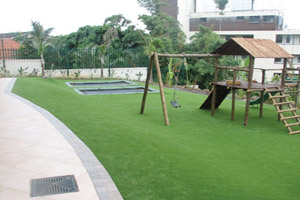
| Artificial turf is a surface of synthetic fibers made to look like natural grass. It is most often used in arenas for sports that were originally or are normally played on grass. However, it is now being used on residential lawns and commercial applications as well. The main reason is maintenance—artificial turf stands up to heavy use, such as in sports, and requires no irrigation or trimming. Domed, covered, and partially covered stadiums may require artificial turf because of the difficulty of getting grass enough sunlight to stay healthy. But artificial turf does have its downside: limited life, periodic cleaning requirements, petroleum use, toxic chemicals from infill, and some heightened health and safety concerns.【More】 |
Applications
| Baseball | Artificial turf was first used in Major League Baseball in the Houston Astrodome in 1966, replacing the grass field used when the stadium opened a year earlier. Even though the grass was specifically bred for indoor use, the dome's semi-transparent Lucite ceiling panels, which had been painted white to cut down on glare which bothered the players, did not pass enough sunlight to support the grass. For most of the 1965 season, the Astros played on green-painted dirt and dead grass. 【More】 |
| In 1969, Franklin Field, the gridiron stadium of the University of Pennsylvania, Philadelphia, Pennsylvania, switched from grass to artificial turf. Also home of the Philadelphia Eagles, it was the first National Football League stadium to use artificial turf. In 2006, Gillette Stadium, the football stadium of the New England Patriots and the New England Revolution, switched from grass to FieldTurf due to the conflict of poor weather and hosting many sporting and musical events at the stadium. It is one of 13 National Football League stadiums that have turf instead of grass fields; the Patriots, Giants and Jets (who share a stadium) and Bengals actually switched from AstroTurf to natural grass before reverting to a next-generation artificial surface. 【More】 | American football |
| Field hockey | The introduction of synthetic surfaces has significantly changed the sport of field hockey. Since being introduced in the 1970s, competitions in western countries are now mostly played on artificial surfaces. This has increased the speed of the game considerably, and changed the shape of hockey sticks to allow for different techniques, such as reverse stick trapping and hitting. 【More】 |
| Some football clubs in Europe installed synthetic surfaces in the 1980s, which were called "plastic pitches" (often derisively) in countries such as England. In England, several professional club venues had adopted them; QPR's Loftus Road, Luton Town's Kenilworth Road, Oldham Athletic's Boundary Park and Preston's Deepdale. QPR had been the first team to install an artificial pitch at their stadium in 1981, but were the first to remove it when they did so in 1988. The last team to have an artificial pitch in England was Preston North End, who removed their pitch in 1994 after eight years in use. 【More】 | Football |
History
| David Chaney – who moved to Raleigh, North Carolina, in 1960 and later served as Dean of the North Carolina State University College of Textiles – headed the team of Research Triangle Park researchers who created the first notable artificial turf. That accomplishment led Sports Illustrated to declare Chaney as the man "responsible for indoor major league baseball and millions of welcome mats." Artificial turf first came to prominence in 1966, when AstroTurf was installed in the Astrodome in Houston, Texas.【More】 |
Advantages and Disadvantages
| | Advantages Artificial turf can be a better solution when the environment is particularly hostile to natural grass. An arid environment or one where there is little natural light are examples. Artificial turf can withstand significantly more use than natural grass and can therefore be used much more frequently. This allows sports ground owners to generate more income from their facilities.【More】 |
| | Disadvantages Some artificial turf requires infill such as silicon sand and/or granulated rubber. Some granulated rubber is made from recycled car tires and may carry heavy metals which can leach into the water table. Alternative sources of infill may provide a safer solution. There is some evidence that periodic disinfection of artificial turf is required as pathogens are not broken down by natural processes in the same manner as natural grass. Despite this, a 2006 study suggests certain microbial life is less active in artificial turf. 【More】 |
More information about Artificial Grass: 【View More】
Written by Dora Men
